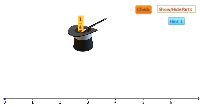Positioning fractions on the number line
Lesson idea. Geogebra has been used to create a simple interactive applet. The applet and guidance notes on how to use it with students are included with the resource.
| Resource details | |
| Title | Positioning fractions on the number line. |
| Topic | |
| Teaching approach | |
| Learning Objectives | |
| Format / structure | Embedded GeoGebra applet and guidance notes. |
| Subject | |
| Age of students / grade | |
| Table of contents | |
| Additional Resources/material needed | |
| Useful information | |
| Related ORBIT Wiki Resources | This activity is a result of the 2013 ORBIT/GeoGebra Competition that asked entrants to create an open-ended activity that supports interactive teaching and active learning for the 6-10 age range. |
| Other (e.g. time frame) | |
| Files and resources to view and download | |
| Acknowledgement | Irina Boyadzhiev |
| License | |
Guidance notes
NEW IMPROVED VERSION HERE - automatically generates new numbers:
http://www.lima.ohio-state.edu/people/iboyadzhiev/GeoGebra/FractionOnNumberLine.html
l. Overview
This applet is designed as a game, giving young students experience with positioning fractions on the number line. At the click of a button a random fraction is generated in the magic hat. The student has to place the fraction on the number line by aligning the fraction with the correct location on the number line. A smiley or frowning face will appear when the “check” button is clicked. The learners can get varying amounts of help, depending on their needs. The first level of help divides the unit segments on the number line in a number of pieces given by the denominator of the fraction. If this assistance is not enough, clicking on the button “Hint1” will show the fraction as a part of a unit square positioned directly above the number line. The last level of help “Hint2” will project the fraction to the number line.
II. Instructions
Activity 1: Introduce the fraction as a part of a whole.
1. Generate a new random fraction by clicking the New Number button.
2. Click Hint1. This will show the unit square, divided in the appropriate number of sections and will color the part representing the fraction. By creating several fractions the students can see different cases of proper and improper fractions. After a few examples they could be asked to create a new fraction and to predict what figure will appear if they click the Hint1 button, then to check their prediction.
Activity 2: Transition from defining the fraction as a part of an object, to seeing it as a point on the number line.
1. Create a new fraction and click on Hint1 to show it as a part of the unit square.
2. Click Show -Hide parts to divide the unit segments into as many parts as the denominator.
3. Click Hint2 to project the part of the square representing the fraction to the number line, thus showing the relationship between them. The students could be asked to drag the fraction from the hat to the red point on the number line and to click on the check button. A smiley face appears for the correct place.
Activity 3: Play the game.
1. Generate a new fraction.
2. Drag it to its place on the number line.
3. Click the Check button. If the position is not correct, the student can get help as described above.
III. Learning objectives
Activity 1: To introduce the fraction as a part of the whole; to understand the role of the numerator and the denominator; to see the whole number as a fraction; to give experience with improper fraction and see them as mixed numbers.
Activity 2: To understand how to determine the the position of a fraction on the number line.
Activity 3: To practice the concepts learned in activities 1 and 2.
IV. Pedagogical Rationale
The students can create many examples for a short time. The constructions are precise, thus eliminating misconceptions created by less accurate hand drawn figures. The game creates an easy transition from the concrete to the abstract-- from a part of a square to a point on the number line.

